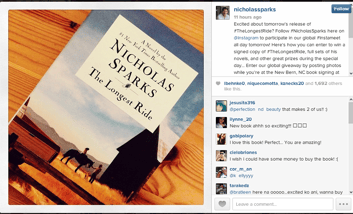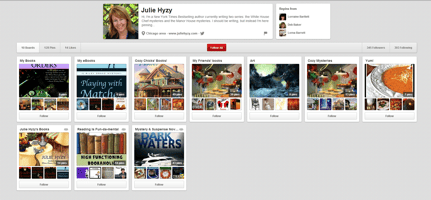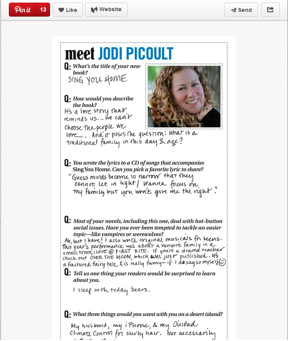by Courtney Gordner (@CourtGordner)
I’ve been trying to get some time to explore the hugely popular social site Pinterest, but without much luck. I get traffic from the boards I do have there, and the biggest one is for the winners of the monthly Ebook Cover Design Awards. So it was good timing when Courtney Gordner told me she’d like to give readers some ideas about how to use this site to promote their books. Here’s her report.
Almost everyone takes part in social media in some way, whether it’s just for work or for personal pleasure. But even those who don’t know much about social media are familiar with some of the bigger sites, like Facebook and Twitter.
But those are just the tip of the iceberg.
- There’s LinkedIn, which is designed to help you build a professional network;
- Vine, which grants users a creative outlet through which they can watch and make 7 second long videos;
- Instagram, which provides a similar service as Vine only with an emphasis on photography rather than film;
and many more. But one network in particular has become very popular very quickly: Pinterest.
Pinterest takes the concept of a personal bulletin board and applies it to an online forum, allowing members to create multiple boards about various topics on which they can “pin” as many lists, pictures, videos, and links as they desire.
Then they can share their boards, allowing their pins to be repined by others. And this is primarily what makes it such a useful tool for authors.
Linking
While Pinterest allows you to create a visually pleasing and informative virtual corkboard, the primary purpose is to use videos and pictures to link to other websites. For an author, this means linking to your own website. To do that, however, you need to make sure there are pictures on your site. They can be:
- book covers,
- book trailers,
- illustrations from your novel,
- fan art,
- even a picture of you and your family.
Then, by sharing your pins on your other social media profiles, you can create even more traffic on your sites.
If you build a connection from your Pinterest page to your website and social media accounts, you’ll increase your traffic. One way authors do this is having contests for readers to participate in.
For example, Nicholas Sparks recently held a contest on Instagram to promote his book signing. Part of the contest was to link to his Facebook page in your comments. In one contest he is promoting two social media sites and his book signing all at the same time.

Instead of Instagram you could promote this on Pinterest and link it with Twitter, or whatever social media mix that seems right for you.
Contests are a great way to interact with fans, link to your other sites and social media pages which will increase traffic. Get creative and tailor the contest to your needs and your fan base. Play off of the themes of various books to keep the contests fresh.
For example, if your book takes place in a poker casino, you might make your contest about “Lady Luck,” where fans tweet their pictures of them going against the odds.
If your book is about a police officer, you might encourage readers to share their stories about their experiences with public service, or with the police. Get creative!
Other uses
Pinterest is used by writers in a number of ways. Some use it to promote book covers, others use it to create individual boards for each of their stories so that readers can get some behind the scenes information, such as different factors that inspired the creation of a favorite character, or actual locations used as settings for each story.
But one major application of Pinterest is its ability to connect writers with their readers. As a result, many of an author’s pins will be repinned by their fans, creating more links to their website.
The ideal Pinterest of an author should include three elements:
- a list of all their books,
- any promotions they are currently doing, and
- updates about their personal life, such as places they have recently travelled and anecdotes from their day.
Here’s an example of Julie Hyzy using Pinterest to promote her books, eBooks, favorite books and her friends books. She also adds a personal touch when she adds her favorite recipes.

The strategy that authors should follow is to pin in a personal manner. Make your boards about you and things that you find interesting. The more your fans connect with you on a personal level, the more they will make an effort to follow you and promote you.
Here’s a way Jody Picoult used Pinterest to let her fans get to know her.

Pinterest can also be used to build excitement around a new book. This can be done by releasing teasers for the cover or inserts of the book leading up to the release date.
Build a board around ideas that inspired this novel. Show the readers where the story line came from by sharing photos of news articles, personal photos or whatever inspired the topic.
Downsides
There are some aspects of Pinterest that keep it from being perfect. One major one is that Pinterest’s users are mostly female, particularly in the United States. However, even if Pinterest will only connect you with your female readers, it is still a useful network.
And if you update your Pinterest boards regularly, you will attract your male readers as well, leading them to join Pinterest and continue sharing your pins.
Another downside is the inability to link sites that have no pictures. This, however, can be easily rectified. All you have to do its make sure there are pictures on your website.
Ultimately, Pinterest is a great tool for authors looking to promote their books online in a creative, fun, and engaging way, and the negatives are nothing compared to the positives.
For any writer looking to engage with their readers as well as reach out to potential readers, Pinterest is the perfect tool.
 Courtney Gorner is a blogger with a passion for all things internet and social media related! Read more from her on her own blog, www.talkviral.com, or connect on Google+.
Courtney Gorner is a blogger with a passion for all things internet and social media related! Read more from her on her own blog, www.talkviral.com, or connect on Google+.


